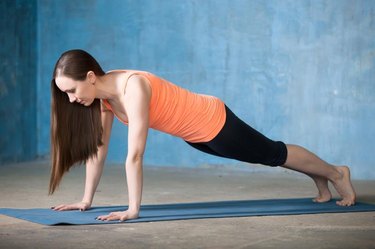
If you've previously injured your neck or back, you should be aware that certain abdominal exercises can aggravate these areas further. Fortunately, there are also many ways to work out that won't strain or hurt you. In fact, many of these are the ideal core exercises for a bad back and neck.
Read more: Ease Upper Back Pain With These Exercises
Video of the Day
Video of the Day
Pain, Strains and Exercise
According to the U.S. National Library of Medicine, 80 percent of people experience back pain in their lifetime. The Mayo Clinic says that back pain can be caused by arthritis, issues related to your spine and muscle or ligament strains.
The U.S. National Library of Medicine says neck pain is also very common. It can be caused by issues with your neck muscles, bones, joints, tendons, ligaments or nerves. It may even be because you've injured your upper arms, shoulders, or head in some way.
Warning
Neck and back pain can be a sign of a serious injury. If your pain is present for more than a few days, your injury could be more serious than a strain. Consider seeing a doctor or consulting a physical therapist if you experience long-lasting or regular pain.
Many popular exercises, like squats or sit-ups, can aggravate existing back and neck injuries. You may also want to avoid certain warm-up exercises, like neck rolls, and specific weight-training exercises.
Read more: 10 Popular Exercises That Can Hurt Your Back
This doesn't mean that you should avoid exercise altogether, though. It's simply important to choose exercises without neck strain or back strain. In fact, there are even core exercises for a bad back and neck that can reduce your pain and prevent further injuries.
Safe Core-Strengthening Exercises
It's completely possible to strengthen the core without hurting the back or neck. In fact, Harvard Health Publishing and an article published in the January 2016 issue of JAMA Internal Medicine reported that exercise is actually capable of preventing back and neck pain.
Harvard Health Publishing recommends swapping crunches or sit-ups for planks, as planks won't strain your back the way sit-ups tend to. Planks also have the added bonus of working a variety of muscles throughout the front, back and sides of your body. Sit-ups only activate a few of your muscles.
The Cleveland Clinic also recommends exercises like side plank and the scissor kick. Gentler movements like the bird dog can also be good core exercises for a bad back and neck.
The bird dog is a particularly good exercise since it has several variations, one of which is the bird dog on a stability ball. You can easily make this exercise harder or easier for yourself by changing where your body is positioned on the ball.
Even simple exercises can help strengthen the core without hurting the back or neck. Harvard Health Publishing recommends exercises like chair stands, single leg raises, heel raises and side leg lifts as good exercises without neck strain. You can also try slightly easier variations of the plank, like a front plank that involves you leaning your upper body on a raised surface, like a table.
If you're trying to exercise more to relieve your neck or back pain, be aware that certain exercises may be more helpful than others. A review published in the March 2015 issue of the _Journal of Physical Therapy Science _reported that core strength training exercises can be particularly helpful in providing back pain relief.
These exercises, which target the body's deep trunk muscles, include trunk balance exercises, segmental stabilization exercises and dynamic exercises, like the camel or cat positions. If you're keen on finding out about other exercises that can help reduce back pain, check out Dr. Stuart McGill's lower back exercises, which are recommended by the American Council on Exercise.
- Journal of Physical Therapy Science: "Core Strength Training for Patients With Chronic Low Back Pain"
- Cleveland Clinic: "Why a Strong Core Is Your Best Guard Against Back Pain"
- Harvard Health Publishing: "Want a Stronger Core? Skip the Sit-Ups"
- Harvard Health Publishing: "Neck Pain: Core Exercises Can Help"
- JAMA Internal Medicine: "Prevention of Low Back Pain: A Systematic Review and Meta-Analysis"
- U.S. National Library of Medicine: "Neck Injuries and Disorders"
- Mayo Clinic: "Back Pain"
- U.S. National Library of Medicine: "Back Pain"
- American Council on Exercise: "Low Back Exercises: Stuart McGill’s Big Three"
- ExRx.net: "Side Plank"
- ExRx.net: "Lying Scissor Kick"
- ExRx.net: "Bird Dog (on Stability Ball)"
- ExRx.net: "Cat Movement"